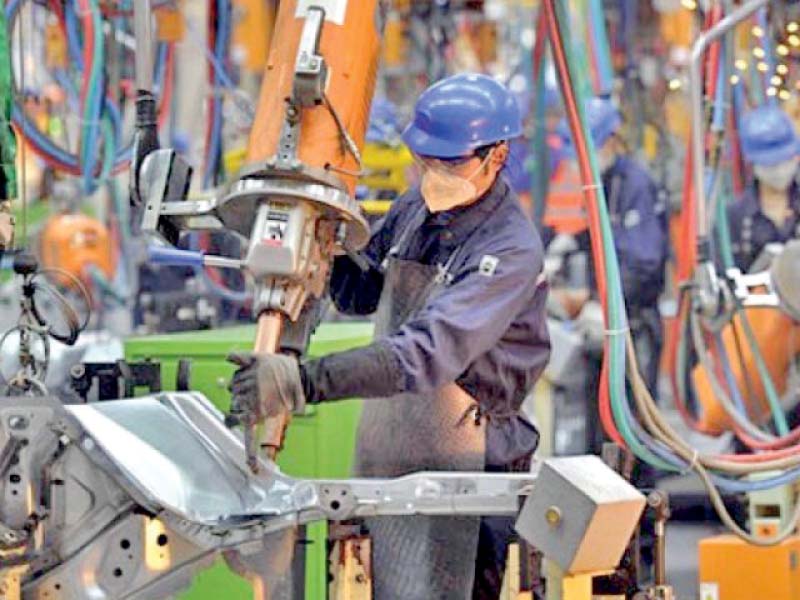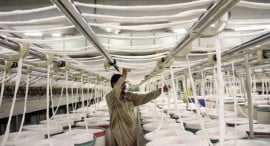
ISLAMABAD: The growth in large-scale industries further contracted by 6.5% in first four months of the current fiscal year due to low demand, which was adversely affected by rising cost of production and working capital.
The Pakistan Bureau of Statistics (PBS) reported on Wednesday that the large-scale manufacturing (LSM) output decreased 6.5% in July-October of the current fiscal year compared to the same period of previous year.
The contraction was steeper in October 2019 as LSM recorded a dip of 8% over the same month of previous year, according to the PBS.
“Cost-push factors have adversely affected the output in large industries,” said former finance minister Dr Hafiz Pasha.
A constant increase in the cost of energy, raw material and working capital due to the doubling of interest rate to 13.25% affected the production cost as well as the profits of firms, he added.
LSM growth drops 5.9% in July-September FY20
The State Bank of Pakistan has pushed the key policy rate to 13.25%, which was 6.5% in May 2018. The real interest rate is currently 5.75% positive as the core inflation reading stood at 7.5% in November.
After earlier increasing gas prices by 161% in two phases, the Pakistan Tehreek-e-Insaf (PTI) government is now again considering hiking gas prices by another 214% with effect from January.
Prices of goods have been increasing at a time when the purchasing power of people is shrinking, which has also affected sales.
Out of 15 major industries, seven big industries recorded some growth while the output in eight industries contracted in the July-October period, according to the PBS.
Despite economic slowdown, growing poverty and unemployment, the SBP kept its key policy rate unchanged at 13.25% in the last monetary policy announcement in November.
Minutes of the second last Monetary Policy Committee (MPC) meeting in September shed some light on the discussions that took place there. The SBP staff apprised the committee that LSM growth projections remained unchanged, according to the minutes.
It was highlighted that growth in the construction and allied industries was likely to recover slightly because of the increase in development budget as compared to last year. However, prospects of the automobile sector were not very promising, according to the MPC deliberations.
Similarly, oil refining is projected to suffer in fiscal year 2019-20 due to a slowdown in economic activities and lower domestic demand for furnace oil because of a change in the power generation mix.
Furthermore, it was discussed that the textile sector was expected to improve in the backdrop of rising exports.
What appears to be surprising was that the MPC took the increase in sales tax revenue as a sign of recovery of domestic demand.
“While discussing the domestic demand in FY20, it was highlighted that there was a significant increase in sales tax revenue during first two months of FY20, which reflected a recovery in domestic demand,” stated the minutes.
The fact of the matter is that the FBR’s sales tax revenues grew due to the delay in release of refunds that were growing rapidly because of the withdrawal of Statutory Regulatory Order 1125. The increase in sales tax collection was almost equal to the worth of refunds that the exporters were claiming for the current fiscal year.
Latest projections by Dr Hafiz Pasha suggested that the number of people living below the poverty line would increase from 69 million in 2018 to 94 million by 2022 - a net addition of 25 million people in first four years of the PTI government.
Growth of LSM industries shrinks 3.3% in July
Prime Minister Imran Khan won the July 2018 elections on the promise of creating 10 million new jobs and constructing five million houses at affordable prices.
Data collected by the Oil Companies Advisory Committee (OCAC) showed that 11 types of industries registered on average 0.91% negative growth in the July-October period of the current fiscal year.
The Ministry of Industries, which monitors 15 industries, reported a 4% decline in the growth of these industries. Similarly, the provincial bureaus reported 1.6% contraction in 11 industries in first four months of the current fiscal year.
Sectors that posted growth on an annual basis included textile which grew just 0.18%, fertiliser which posted a growth of 10.7% and non-metallic mineral products which recorded 0.4% growth.
Manufacturing of leather products recorded 7.7% growth, engineering products registered an increase of 8.3%, rubber products 1.6% and wood products 60% during the July-October period.
In case the government decides to increase gas prices, it will push fertiliser prices upwards, which can affect its demand as well.
Industries that were producing eight major types of goods recorded a dip in their manufacturing in July-October 2019. The production of food, beverages and tobacco went down 8.4%, coke and petroleum products fell 13.8%, pharmaceuticals 10.3%, chemicals 8.8%, automobiles 36%, iron and steel products 15%, electronics 8.8% and paper and board 2.2%.
Published in The Express Tribune, December 19th, 2019.
Like Business on Facebook, follow @TribuneBiz on Twitter to stay informed and join in the conversation.



















































COMMENTS
Comments are moderated and generally will be posted if they are on-topic and not abusive.
For more information, please see our Comments FAQ